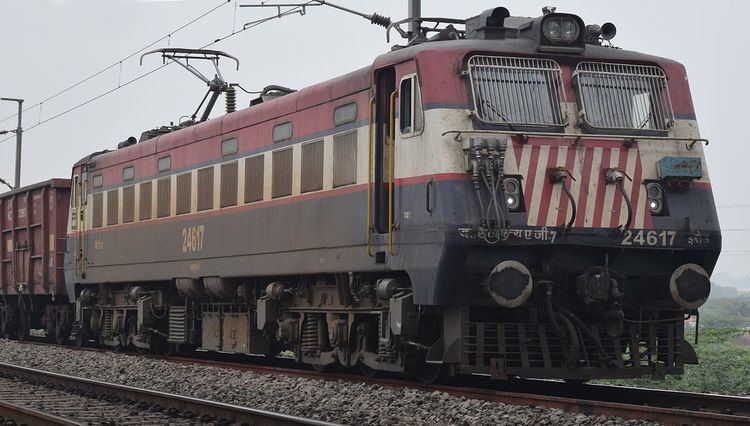Power type Electric Gauge 5 ft 6 in (1,676 mm) | UIC class Co′Co′ Bogies ALCO Fabricated | |
 | ||
Builder WAG-7 and WAG-7H : Chittaranjan Locomotive Works(CLW)WAG-7 : Bharat Heavy Electricals Ltd.(BHEL) and Total produced WAG-7 : 1970WAG-7H : 2 | ||
WAG 7 is the name of a type of electric locomotive used in India. It is the 7th class of Wide Gauge's(W) AC charged(A) and Freight-dedicated(G-Goods) locomotives. Built by Chittaranjan Locomotive Works and BHEL, Jhansi to RDSO specifications. WAG7 is an uprated version of WAP-4B locomotive with high capacity transformer, rectifier, traction motor, compressor and other matching associated equipments. On 3 August 1992, the first WAG-7 locomotive was inaugurated and christened the name 'SHANTIDAN' in honor of Mother Teresa. The loco is controlled by a tap changer. Indian Railway is going to achieve 7,000,000 tonnes (6,890,000 long tons; 7,720,000 short tons) of traffic, WAG 7 is the main stay of loco. In the locomotive vehicle market WAG 7 is more economical option and one of the most affordable in the world. Hence, it has the highest production figures of any locomotive in India.
The first 71 of this class initially or still homed at Mughalsarai (MGS) shed and the second was Kanpur (CNB). Some units are retrofitted with Static Converters(STC) instead of Arno Rotary Converters. STCs are more efficient and require less maintenance. Also, STCs have self diagnostics making troubleshooting easier. WAG-7H is a heavy variant of WAG-7. WAG-7H #28739 has thicker under-frames. WAG-7 #27445 has closed-circuit cameras to monitor the pantograph along with a spotlight to illuminate the same at night, green lamps to exchange signals and a single windscreen on either side. New Katni (NKJ) shed has added Overhead Equipment(OHE) monitors. Some WAG-7 units have A.C. cabs, SIV, MPFDCS, MPCS, Single arm pantograph, FDCS, Additional COC, Rear-view mirrors, STS, Daulat Ram's Roof-mounted DBRs, SI, Modified ceilings, Bucket seats, Waist-level headlamps, High-reach pantographs, Vigilance Control Device(VCD), Wireless Multiple Control, Vertical Dynamic Brake Resistor(DBR) and microprocessor control. Some units have their MU cables removed. One unit has SCHUNK pantograph. Some units are assembled at Dahod Workshops. Initially WAG-7 had the body-shell similar to WAG-5 but later on all WAG-7 are/were fitted with WAP-4 shell since this provided more space. WAG-7H have WAP 4 shell since beginning. Older WAG-7s have Tiger Face liveries (Red/Dark Blue on white) but newer WAG-7s by CLW have yellow stripe on blue livery. All BHEL built WAG-7s have Tiger Face livery. Now, even some older WAG-7s are repainted with yellow stripe on blue livery. It is also the most powerful indigenously designed freight-dedicated locomotive in India.
Performance
WAG-7 with a gear ratio of 18:64 has the following capacity while hauling BOX wagons (in tonnes):
WAG-7 with a gear ratio of 18:64 has the following capacity while hauling BOXN wagons (in tonnes):
WAG-7 with a gear ratio of 65:16 has the following capacity while hauling BOXN wagons (in tonnes):
WAG-7H has the following capacity while hauling BOX wagons (in tonnes) :
WAG-7H has the following capacity while hauling BOXN wagons (in tonnes) :
